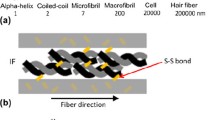Abstract
KERATIN, the protein of mammalian hairs and related epidermal tissues, the fibrous proteins of the epidermis itself, and myosin2, the principal protein of muscle tissue, all fall into one great group of fibrous proteins that have a common molecular configuration and similar long-range elastic properties. This generalization follows from a series of X-ray and supporting investigations that hare been described among other places in NATURE1. There will perhaps be no need then to summarize them again here, beyond recalling that the structural unit of the group is a ‘grid’ consisting of long polypeptide chains cross-linked by means of their side-chains, that the main-chains of this grid are not normally in the extended configuration but are thrown into a sequence of folds transverse to the side-chains, and that when the fibres are stretched the grid is pulled out flat, only to return to its folded configuration when the tension is released. The normal folded configuration we have called a, the extended configuration β, and the reversible intramolecular transformation from a-keratin (or a-myosin) to β-keratin (or β-myosin) is the basis of the remarkable long-range elastic properties of this group of protein fibres.
Similar content being viewed by others
References
See also Astbury, W. T., Jubilee Memorial Lecture of the Society of Chemical Industry, Chem. and Ind. (in press), and 60, 41 (1941).
Astbury, W. T., and Dickinson S., Proc Roy. Soc, B, 129, 307 (1940).
Pauling, L., and Niemann, C., J. Ameu Chem. Soc, 61, 1860 (1939).
Astbury, W. T., Trans. Faraday Soc., 36, 871 (1940).
Neurath, H., J. Phys. Chem., 44, 296 (1940).
Astbury, W. T., and Street, A., Phil. Trans. Roy. Soc., A, 230, 75 (1931); Astbury, W. T., and Woods, H. J., ibid., A, 232, 333 (1933); Astbury, W. T., and Sisson, W. A., Proc. Roy. Soc., A, 150, 533 (1935); Astbury, W. T., J. Text. Inst., 27, P282 (1936); Woods, H. J., Proc Roy. Soc., A, 166, 76 (1938).
Astbury, W. T., Trans. Faraday Soc., 29, 193 (1933).
See, for example, Bull, H. B., Cold Spring Harbor Symposia on Quantitative Biology, 6, 140 (1938).
Astbury, W. T., Dickinson, S., and Bailey, K., Biochem. J., 29, 2351 (1935).
Pauling, L., ‘The Nature of the Chemical Bond” (1939).
Astbury, W. T., NATURE, 140, 968 (1937); Astbury, W. T., and Bell, F. O., Cold Spring Harbor Symposia on Quantitative Biology, 6, 109 (1938).
A full discussion will be given elsewhere. In the meantime, we should like to make it clear that no responsibility for the precise residue numbers chosen attaches to the protein analysts whose experimental results have been utilized.
Astbury, W. T., NATURE, 137, 803 (1936). Pauling has recently put forward a similar suggestion in J. Amer. Chem. Soc., 62 2643, (1940)).
Author information
Authors and Affiliations
Rights and permissions
About this article
Cite this article
ASTBURY, W., BELL, F. Nature of the Intramolecular Fold in Alpha-Keratin and Alpha-Myosin. Nature 147, 696–699 (1941). https://doi.org/10.1038/147696a0
Published:
Issue Date:
DOI: https://doi.org/10.1038/147696a0
- Springer Nature Limited
This article is cited by
-
Cellulose-microfibril-orienting mechanisms in plant cells walls
Planta (1988)
-
Licht- und elektronenmikroskopische Untersuchungen an der Schalenhaut und Kalkschale des H�hnereies
Zeitschrift f�r Zellforschung und Mikroskopische Anatomie (1961)





